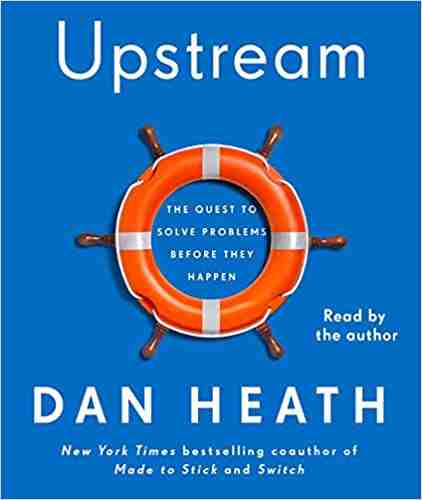Every month, a handful of my clients complain that there is just not enough time in the day to get everything done. They share that they are consumed with putting out fires and reacting to issues, which leaves them very little time to do their scheduled work activities. If this sounds like you, you are not alone. However, there is a way out, but it involves upstream thinking.
What is upstream thinking all about? Upstream thinking is a metaphor for problem prevention. While downstream actions react to problems once they’ve occurred, upstream thinking causes you to look at ways to prevent those problems from ever happening in the first place. By their nature, downstream efforts are narrow, fast, and tangible, requiring immediate attention. Upstream efforts, in contrast, are broader, slower, and less tangible, and as a result, seem less urgent to deal with today so they get put off.
In the book Upstream: The Quest to Solve Problems Before They Happen by Dan Heath, Dan explains how upstream thinking can save you time and money and shared the example of Expedia.
As we all know, Expedia is a self-service website designed to allow people to book flights, hotels, and car rentals from the comfort of their home, without the need of humans such as travel agents. However, what Expedia experienced was a large volume of customer support calls, even though booking travel on Expedia was supposed to limit the need for human intervention. Alarmed by the number of calls, Ryan O’Neill, the head of Customer Experience, dug into the numbers and discovered that 58% of customers who used Expedia were placing a call to customer services after they booked a trip.
Why did so many Expedia clients see a need to call customer service after booking a trip? What Expedia discovered was that most callers simply wanted to get a copy of their itinerary. This was a very costly problem for Expedia, which recorded about 20 million customer service calls annually, at a cost of about $5.00 per call, for this reason alone.
So how is the Expedia problem related to upstream thinking? Organizations have a natural tendency towards downstream thinking and Expedia was no exception.
“When you spend years responding to problems, you can sometimes overlook the fact that you could be preventing them,”
Dan Heath
In the end, Expedia simply added a print button and automatically mailed the literature to every customer that booked travel with them. After this fix, the 20 million customer support calls nearly completely evaporated, saving the company tens of millions of dollars each year. It took upstream thinking on the part of Expedia to look at the systemic factors that influenced the problem.
So, why was this problem at Expedia allowed to continue? In short, problem blindness, stovepipes that prevented ownership of the problem, and the overwhelming nature of the daily downstream firefighting that never allowed time for upstream thinking.
Let’s explore the three main barriers to upstream efforts which can be summarized as: I don’t see the problem; It’s not mine to fix; I can’t deal with that right now.
Problem blindness – “I don’t see the problem”
Problem blindness is the belief that negative outcomes are natural or inevitable. As Dan said:
“When you are blind to a problem, you tend to treat it like the weather. You know it’s bad, but ultimately, what can you do about it, it’s the weather.”
Dan Heath
How can you solve an issue when no one sees it as a problem because it is seen as normal?
Problem blindness creates passivity, even in the face of enormous harm. Problem blindness explains why extraordinarily smart people do extraordinarily dumb things or make bad decisions.
One way to awaken an organization to problem blindness is to give the problem a name. Lin Farley coined the term “sexual harassment”, giving a name to a problem that had been normalized in the workplace, made the problem something abnormal and unacceptable, and empowered women by defining a collective experience under a single name.
Lack of Ownership – “It’s not mine to fix”
Upstream thinking requires system thinking. In the Expedia example, there was a product group whose goal was to maximize bookings, a tech group whose goal was to keep the site operating bug-free, and a customer support group whose goal was to solve problems for customers as fast as possible. Each group operated in a silo and there was no formal way for the different groups to communicate with each other. While each group may have seen evidence of the problem, the cause and effect were hard to associate given the lack of communication between the groups and it was not in their charter to try to fix it.
Moreover, as is the case with most businesses, if you identify a problem, you will be put in charge of implementing a solution. Since upstream thinking requires coordination, there is always the risk that you could start a turf war and the solution may not produce the desired results. Therefore, most employees feel that it is better to keep their heads down and let someone else deal with the problem.
According to Doug Davidoff in his blog post on Imagine Business Development, there’s a variation to problem blindness that he calls Solution Blindness. Even when someone knows there’s a problem and is not blind to it, if they don’t feel they have a sense of what it takes to create a solution, they act as though they don’t see the problem.
What’s frustrating about upstream work is that, despite the enormous stakes, it’s often optional. With downstream activities, the work is demanded of us. A doctor can’t opt out of performing heart surgery, a daycare worker can’t opt out of doing a diaper change. By contrast, upstream work is chosen, not demanded.
Upstream efforts can be put off indefinitely, which they often are because resources are dedicated to corrective actions. Even if a problem is identified, few businesses stop long enough to focus on upstream thinking, consider what is causing the problem, and look at upstream actions to try to fix it.
Furthermore, most managers are compensated based on the number of direct reports they manage or the size of their budget. If your solution dramatically reduced the time and money needed by your department, would that not translate into having less responsibility? As a manager, your goal is not to get fired or demoted since you have assumed a certain lifestyle. You own a big house, drive nice new cars, maybe have a country club membership, and lots of successful friends. The last thing you want is to get fired and lose your lifestyle because your solution made you irrelevant. Therefore, in many corporate cultures, it would not be a good career decision to volunteer to be the owner of the problem or solution that could reduce your importance in a company.
As the leader, your responsibility is to encourage communication by setting up cross-functional teams that meet regularly and allocating a specific budget and time.
Tunneling – “I can’t deal with that right now”
Juggling multiple problems can lead to tunnel vision. There isn’t enough mental bandwidth to solve them all, resulting in short-term, narrow, and reactive thinking. When resources such as time and money are scarce, every problem becomes a source of stress, leading to putting out one fire after another without the bandwidth required to prevent the problems in the first place. As a result, tunneling leads to more tunneling in a vicious spiral.
Psychologists Eldar Shafir and Sendhil Mullainathan, in their book Scarcity: When Having Too Little Means So Much, said “The conditions of scarcity, be it money or time, makes bad things happen.” To demonstrate their concept of the psychological effects of scarcity, Eldar gave a talk at the Aspen Institute, giving an example of packing for a trip.
If you have a large suitcase, you can add lots of items. However, if you have a small suitcase, you can only pack the essentials and have to leave things out that have marginal utility. If during your trip you find something like a pair of shoes and you have a big suitcase, you have the capacity, and all you need to consider is the value of the shoes. However, if you have a small suitcase, you have to ask yourself what you have to take out of your already full suitcase if you buy the shoes. This is far more labor-intensive, and you’ll be prone to leaving out an essential item to make room for the shoes.
When you translate the suitcase example to businesses having a scarcity of resources, the planning process requires more attention as you consider trade-offs, is prone to more errors, and creates difficulty.
In business, when people are juggling a lot of problems, they give up trying to solve them all. They look for the easy and the tangible items to focus on and can’t engage in systems thinking. They can’t prevent problems; all they can do is react. Tunneling dooms businesses to stay in an endless cycle of reaction.
How does a business escape the tunnel? You need to build in slack. Slack, in this context, means a reserve of time or resources that can be spent on problem-solving. This is where minimizing the cognitive load on teams is so important. Without the slack, the teams won’t think systemically. As a leader, you need to create an urgent demand to fix a problem that may not happen for a while.
7 Critical Questions for Leaders
1. How will you unite the right people?
Upstream work often involves volunteer efforts, “chosen, not obligated”. People volunteer to take ownership of a problem to prevent it, so it’s important to motivate people to undertake this work. Choose people close to the problem with the experience and authority to make a difference. Align people’s efforts towards a shared vision, focused on preventing specific instances of the problem. Get people to focus on data for the purpose of learning rather than data for the purpose of inspection. Data for inspection is often target-focused, to penalize those who fall short, which can lead to gaming the system. “Why did you miss your target?” Instead, focus on learning why and how to improve going forward. “What steps did you follow and what could have been done differently that would have enabled you to hit your target”
2. How will you change the system?
Upstream work is about reducing the probability that problems will happen, and for that reason, the work must result in a system change. Upstream work involves fighting against people and groups that have become used to the system, who tacitly accept its flaws and the status quo, perhaps because in some way they benefit from the system or it’s simply much easier to become resigned to it. Therefore, the right people need to be assigned by the leader and need to unite around a common cause and demand change.
3. Where Can You Find a Point of Leverage?
As the leader, spend part of your time from a vantage point that allows you to see the whole system, not just the problem that may have caused you to focus on the system in the first place. Finding leverage points requires immersing yourself in the problem, to understand the issues that contribute most to it.
4. How Will You Get an Early Warning of the Problem?
The aim is to design a “smoke detector” alarm system forewarning you of a problem to come, so you can take upstream action to prevent the problem from occurring. You do not want a warning system that generates too many false positives, leading to alarm fatigue where people end up ignoring the alarms. However, where the impact of missing a problem would be devastating, you should be willing to accept a high rate of false positives.
5. How Will You Measure Success?
Upstream efforts have a maddening ambiguity that makes them hard to measure. Success is much more tangible for downstream interventions, which is why organizations have a natural tendency towards downstream thinking. After all, how can you measure success when success is defined as something that doesn’t happen? What you want to avoid are what Dan calls Ghost Victories. Ghost victories are defined as superficial successes that cloak failure.
6. How Will You Avoid Doing Harm?
Upstream interventions tinker with complex systems and, as such, you should expect reactions and consequences beyond the immediate scope of work. Systems are too complex to be controlled, but they can be redesigned. Ask yourself if you are intervening at the right level of the system and what are the secondary effects of your interventions? Implement change as experiments and make changes through multiple iterations. Ensure that you have the feedback mechanisms in place to navigate your way through your complex systems.
7. Who Will Pay for What Does Not Happen?
The cost of downstream work often far exceeds the cost of upstream work, but there is often resistance to pay for the upstream work. After all, who will pay for what does not happen? In government, they often refer to the “wrong pocket problem” which is a situation where the entity that bears the cost of the intervention does not receive the primary benefit. One pocket pays, but the returns are scattered across many pockets. Paying for upstream efforts ultimately boils down to three questions:
- Where are the costliest problems?
- Who is in the best position to prevent those problems?
- How do you create incentives for someone to resolve them?
How can you use upstream thinking to save time and money in your organization?












